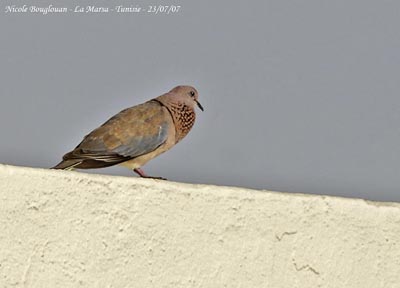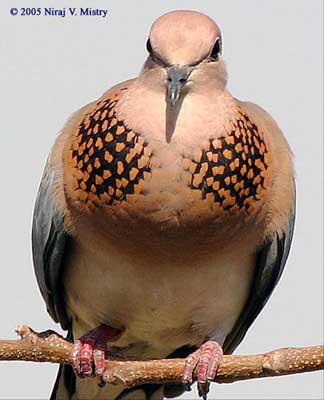
Fr: Tourterelle maillée
All: Palmtaube
Esp: Tórtola Senegalesa
Ital: Tortora senegalese
Nd: Palmtortel
Sd: Palmduva
Photographers:
Aurélien Audevard
OUESSANT DIGISCOPING
Didier Buysse
Vision d’Oiseaux
Steve Garvie
RAINBIRDER Photo galleries
Niraj V. Mistry
Photo Galleries
Nicole Bouglouan
PHOTOGRAPHIC RAMBLE
Text by Nicole Bouglouan
Sources:
HANDBOOK OF THE BIRDS OF THE WORLD vol 4 by Josep del Hoyo-Andrew Elliott-Jordi Sargatal - Lynx Edicions - ISBN: 8487334229
PIGEONS AND DOVES by David Gibbs, Eustace Barnes and John Cox - Pica Press Sussex - ISBN: 1873403607
BIRDS OF THE GAMBIA AND SENEGAL by Clive Barlow and Tim Wacher – Helm Field guides – ISBN: 0713675497
BIRDS OF THE MIDDLE EAST by R.F. Porter, S. Christensen, P Schiermacker-Ansen C.Helm - ISBN: 0713670169
ENCYCLOPEDIE DES OISEAUX DE FRANCE ET D’EUROPE – de Peter Hayman et Rob Hume - Flammarion – ISBN : 2082009920
THE HANDBOOK OF BIRD IDENTIFICATION FOR EUROPE AND THE WESTERN PALEARCTIC by Mark Beaman, Steve Madge - C.Helm - ISBN: 0713639601
Laughing Dove
Streptopelia senegalensis
Columbiforme Order – Columbidae Family
BIOMETRICS:
Length: 25-27 cm
Wingspan: 40-45 cm
Weight: 70-92 g
DESCRIPTION:
The Laughing Dove has peculiar feature, making it different from other Columbidae species. This dove has the feathers used in displays on the foreneck, instead of the nape or the hindneck.

This dove has pinkish head. A broad band of black feathers with cinnamon tips crosses the foreneck and the upper breast. Mantle, scapulars and inner coverts are reddish-brown to orange-brown. Outer coverts, back and rump vary from blue-grey to pale grey.
On the upperparts, the male adult has mauve-pink head and hindneck. Back and most part of wing coverts are reddish to red-brown. Rump and uppertail-coverts are blue-grey.
The throat is mauve-pink, with paler chin. We can see a broad band of golden copper feathers with black base on foreneck and neck sides.
On the underparts, the breast in mauve-pink and the belly is creamy-white. Undertail-coverts are white.
On the upperwing, the inner coverts are reddish to red-brown, as the back. The outer coverts are blue-grey. The primary and secondary flight feathers are brown to blackish-grey. The uppertail shows grey-brown central rectrices, whereas the outer ones are grey and white-tipped.
The bill is dark grey-brown. The eyes are dark brown. Legs and feet are purple-pink.
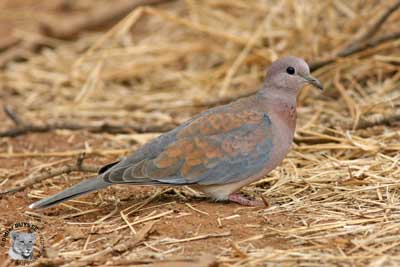
The female is similar in plumage but duller than male.
The juvenile is paler and lacks the neck pattern.
We can find five subspecies which differ in size and colour intensity.
VOICE: SOUNDS BY XENO-CANTO
The Laughing Dove’s song resembles a human laugh. This variable and unobtrusive phrase of 6-8 soft notes “cou ku RU kuru-koou” can be hear all year round, included at night, but less frequently.
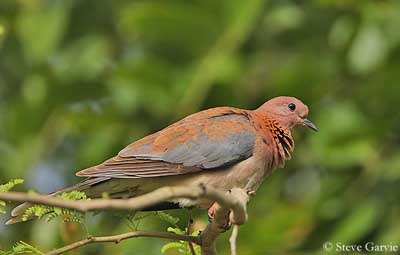
HABITAT:
The Laughing Dove frequents dry areas, wooded savannahs, thickets of acacias at some kilometres from water. This species nests in bushes or trees. It is resident in urban areas, large towns and villages.
RANGE:
The Laughing Dove is present in Africa and Asia. Its African range includes the most part of the continent except the Sahara and some western regions.
From Asia, it disperses to India. The species has been introduced in Australia.
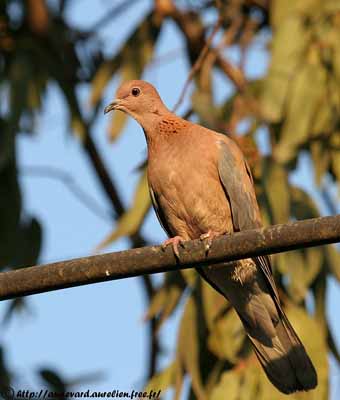
BEHAVIOUR:
The Laughing Dove feeds on the ground where it walks easily and rapidly. It forages near shrubs, and may take fruits and seeds from plants.
This dove is usually seen alone or in pairs, or in small groups of 3-4 birds, but they can gather in large flocks, up to several hundreds at water and food sources.
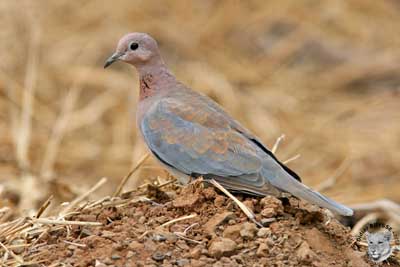
During the threat displays, the male chases the intruders with inflated neck and erect head, in order to expose the scaled pattern of the foreneck. This display is accompanied by low, deep, rapid series of “couus”.
This behaviour can be associated to the courtship displays, but that is a way to impress the intruders entering the territory. Usually, the opponent does not insist for long time, but if it remains, they fight with strong wing strikes.
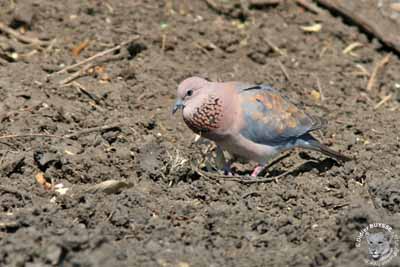
The Laughing Dove is sedentary with some seasonal movements, but in some regions of Africa and India, the species may be partially migratory.
FLIGHT:
The Laughing Dove has powerful and fast flight as in other Columbidae species.
The flight display shows the male leaving its perch with noisy wing-beats, and then raising at considerable height before to descend by gliding with spread wings and tail.
REPRODUCTION:
The breeding season varies according to the range.
The Laughing Dove is monogamous, solitary and territorial. The pair-bonds are for the life.
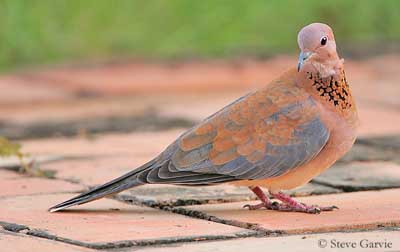
This species breeds all year round and nests in trees and shrubs. The nest is a flimsy platform built by the female, made with roots, twigs and stems often brought by the male. It is usually situated between 3 and 15 metres above the ground. The same nest can be used several times, and some doves use old abandoned nests of other birds’ species.
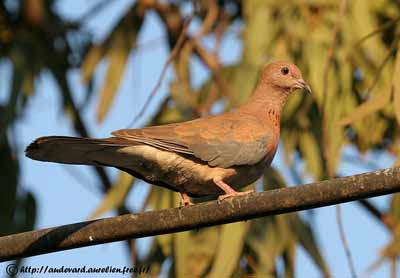
The female lays two glossy white eggs. The incubation lasts about two weeks mainly by the female, but the male may replaces her sometimes. The chicks have reddish skin and yellowish down.
They leave the nest 12-13 days after hatching but they do not fly. They are fed by regurgitation and they fledge at 15-17 days of age.
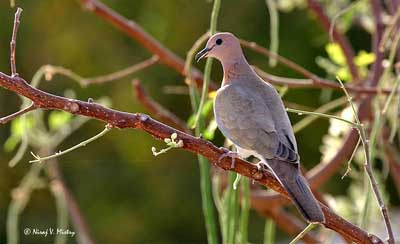
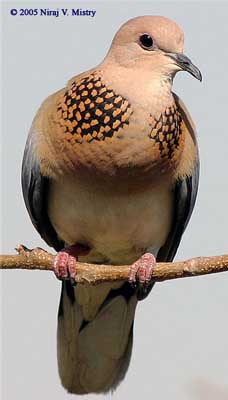
DIET:
The Laughing Dove feeds on grains and seeds, but also takes small insects, flies, ants and termites. This species favours the sunflower seeds and the grains of maize. In addition, it consumes fruits, nectar from Aloe, some invertebrates and small snails.
PROTECTION / THREATS / STATUS:
The Laughing Dove is not threatened. The species is common and widespread in most part of the range. It adapts to all environments, making it able to survive, including in the introduced ranges.
